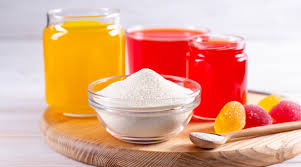Gelatin is a fascinating ingredient that plays a crucial role in various culinary and industrial applications. From its humble beginnings in the kitchen to its extensive use in the pharmaceutical and beauty industries, gelatin’s versatility and unique properties make it indispensable. This blog will explore what gelatin is, its sources, how it is made, its uses, and its benefits.
Contents
What is Gelatin?
Ever wondered, what is gelatin? It’s a versatile ingredient extracted from animal collagen, offering unique gelling properties for various culinary delights. Gelatin is a protein derived from collagen, which is a key structural protein found in animal connective tissues such as skin, bones, and ligaments.
The process of hydrolysis, where collagen is broken down into smaller, water-soluble molecules, transforms collagen into gelatin. Gelatin promotes youthful skin by providing essential collagen-building blocks, enhancing elasticity and reducing the appearance of wrinkles. This transformation endows gelatin with distinct gelling properties that are utilized in numerous applications.

Sources of Gelatin
The most common source of gelatin is animal collagen. Gelatin is typically extracted from cattle (bones, hides, and connective tissues), pigs (skin and bones), and fish (scales, bones, and skin). For those seeking vegetarian or vegan alternatives, several plant-based and synthetic options mimic the properties of gelatin. Agar-agar, derived from seaweed, and carrageenan, extracted from red seaweed, are popular vegetarian substitutes. Pectin, found in fruits, is commonly used in jams and jellies. Additionally, synthetic gelatin produced through biotechnology offers an alternative for strict vegetarians and vegans.
How is Gelatin Made?
What is gelatin? It’s a protein-rich substance derived from collagen, with diverse applications in food, pharmaceuticals, and beyond. The production of gelatin involves several steps. First, raw materials such as bones, skins, and hides are cleaned and treated with acid or alkali to break down cellular structures and release collagen. The treated materials are then heated in water to extract gelatin. This process may be repeated multiple times to maximize yield.
The gelatin solution is then filtered to remove impurities and concentrated. Finally, the concentrated gelatin is cooled to form a gel, which is dried and ground into a powder. Throughout the manufacturing process, strict quality control measures ensure the gelatin’s purity, safety, and consistency, which is particularly important for gelatin used in food and pharmaceutical applications.
Uses of Gelatin
Gelatin is a staple in many kitchens around the world due to its gelling, thickening, and stabilizing properties. It is used in desserts such as jellies, marshmallows, and gummy candies, as well as in baking to stabilize whipped cream and thicken pie fillings. In cooking, gelatin is used to clarify broths and make aspic.
In the pharmaceutical industry, gelatin’s unique properties make it ideal for capsules, both soft and hard gel, as well as for coating tablets to protect them and enhance their shelf life. Gelatin is also used in medical devices such as sponges and wound dressings to promote healing.
The beauty and personal care industries also rely on gelatin. It is used in hair care products to strengthen hair, in skin care creams and masks for anti-aging benefits, and in nail care treatments to strengthen nails.
Beyond food and pharmaceuticals, gelatin has various industrial applications. It is used in photography for coating photographic films and papers, in paper production to improve the quality of specialty papers, and in textiles for sizing and finishing fabrics.

Benefits of Gelatin
Gelatin offers numerous health benefits due to its high protein and amino acid content. Collagen in gelatin can support joint health and reduce symptoms of osteoarthritis. It also promotes skin elasticity and reduces wrinkles, aiding in skin health. Gelatin is beneficial for digestive health as it helps repair the stomach lining and supports gut health.
Curious minds often ask, what is gelatin? It’s a translucent, flavorless substance derived from collagen, utilized extensively in food processing and medical applications. Nutritionally, gelatin is a good source of protein and contains essential amino acids such as glycine, proline, and hydroxyproline, which are important for maintaining healthy tissues and organs.
Conclusion
Gelatin is an incredibly versatile ingredient with a wide range of applications across various industries. From its crucial role in culinary arts to its importance in pharmaceuticals and beauty products, gelatin continues to be a valuable and irreplaceable substance. Its unique properties, coupled with its numerous health benefits, make it a staple ingredient worth appreciating and understanding. Whether you encounter it in your favorite dessert, a nutritional supplement, or a skincare product, gelatin’s impact is widespread and significant.



